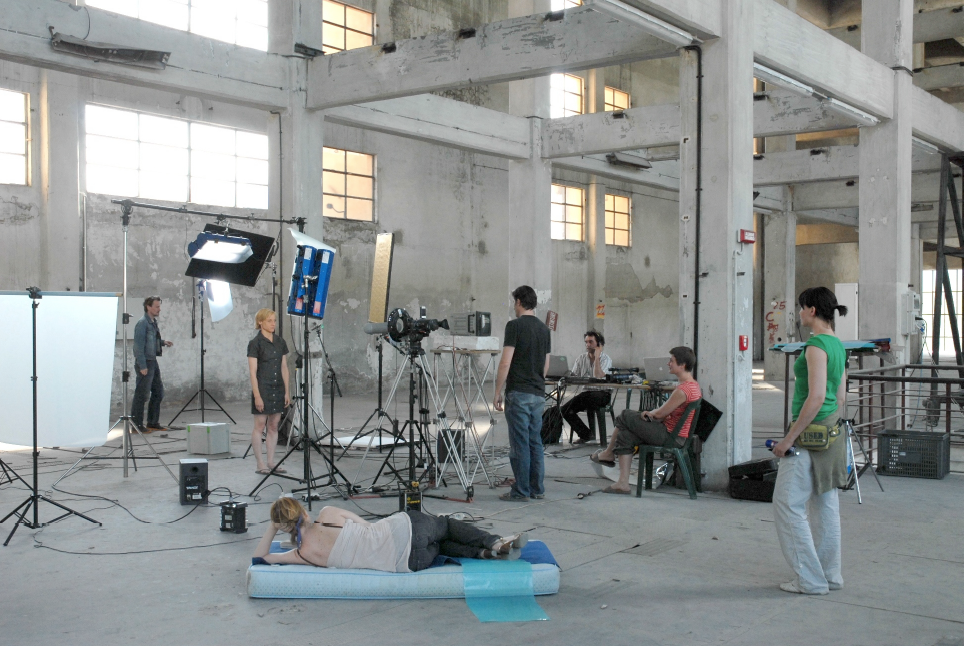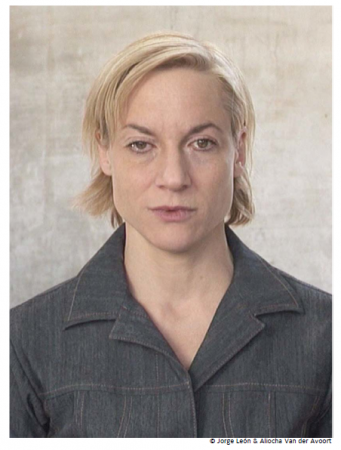Artist: Meg Stuart (EE UU)
The face is at once the irreparable being-exposed of humans and the very opening in which they hide and stay hidden. The face is the only location of community, the only possible city.
Giorgio Agamben
In 2008, Meg Stuart was invited to Manifesta7. She came to Bolzano to work with a small crew on the second floor of the Allumix Building. The aim: to shoot a video. Time foreseen: six days of work. The face-to-face videos of Vito Acconci came to mind, time capsules of compressed presence revolving around simple actions and relational axes.
“I think of images as excavation sites. To vacillate between the simplest of gestures, working the trace suspended in repetition, the face: the prime canvas. The close-up as a means to hone the optical unconscious and involuntary memories of everyday behavior, singular and collective, manufactured and fractured at the same time.
What’s in the timing of things? Every work is made under the specifics of a time regime. To choreograph is to come to terms with that regime. To dance is to traverse it. Face it.” (Meg Stuart)
Meg Stuart (New Orleans, USA, 1965) is an American choreographer and dancer, born in New Orleans, living and working in Berlin and Brussels. As a daughter of theatre directors, she began dancing and acting at an early age in California and regularly performed in her parents’ productions and those made by family friends. She made her first dance studies as a teenager focusing on simple movement actions. Stuart decided to move to New York in 1983 and studied dance at New York University. She continued her training at Movement Research where she explored numerous release techniques and was actively involved in the downtown New York dance scene.
At the invitation of the Klapstuk festival in Leuven (1991), she created her first evening-length piece,
Disfigure Study , which launched her artistic career in Europe. In this choreography, Stuart approached
the body as a vulnerable physical entity that can be deconstructed, distorted or displaced but still resonates and has meaning. Interested in devising her own structure through which to develop artistic projects, Stuart founded Damaged Goods in Brussels in 1994. Damaged Goods is a flexible, open structure that facilitates the production of highly diverse projects and interdisciplinary collaborations. Meg
Stuart and Damaged Goods have created a wide range of productions, from solos to large-scale choreographies, site-specific creations, installations and improvisation projects.
Stuart strives to develop a new language for every piece in collaboration with artists from different creative disciplines and navigates the tension between dance and theatre. The use of theatrical devices, in addition to the dialogue between movement and narrative, are recurrent themes in her choreographies. Stuart’s choreographic work revolves around the idea of an uncertain body, one that is vulnerable and self-reflexive. Through improvisation, she explores physical and emotional states or the memories of them. Her artistic work is analogous to a constantly shifting identity. It constantly redefines itself while searching for new presentation contexts and territories for dance.
Meg Stuart/Damaged Goods has an on-going collaboration with the Kaaitheater (Brussels) and HAU
Hebbel am Ufer (Berlin). Invited by intendant Johan Simons, 2015-2017 the company will be collaborating
with Ruhrtriennale. In 2015-2016, Meg Stuart/Damaged Goods is touring VIOLET (2011), Built to Last
(2012), An evening of solo works (1013), Sketches/Notebook (2013), Hunter (2014) and UNTIL OUR
HEARTS STOP (2015).
Concept & performance Meg Stuart
Photography & editing Jorge León & Aliocha Van der Avoort
Produced by Raqs Media Collective and Damaged Goods for Manifesta 7
Courtesy of Manifesta 7 (Italy) and Meg Stuart/Damaged Goods (Belgium)
Meg Stuart & Damaged Goods are supported by the Flemish authorities and the Flemish Community Commission
Place: Caffarena
Address: Compañia 2614 and Cueto 374
Type of Protection: Typical Zone
Caffarena textile factory, founded in 1920, was first located on 1510 San Pablo Street, then moved to the houses located on 2614 Compañia Street and 374 Cueto.
Blas Caffarena Chiozza, a Genoese who arrived in Chile in 1888, settled first in Iquique and then moved to Antofagasta, then to Arica, and finally returned to his homeland. Between 1917 and 1918 he settled on the East Coast of the United States, testing new weaving machines and studying dyeing with aniline. In 1920 he returned to Santiago with his machine, his wife and seven children, who included Elena Caffarena (1903-2003), a feminist leader who fought to claim the role of women in society.
The Caffarena factory consolidated quickly, contributing to Yungay and giving a small scale industrial neighborhood character. The factory has survived countless crises, positioning itself as a renowned company in the field in Latin America.

